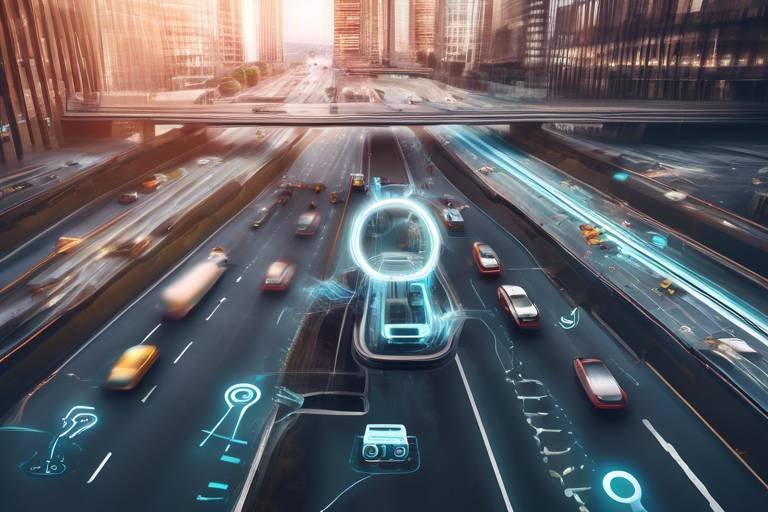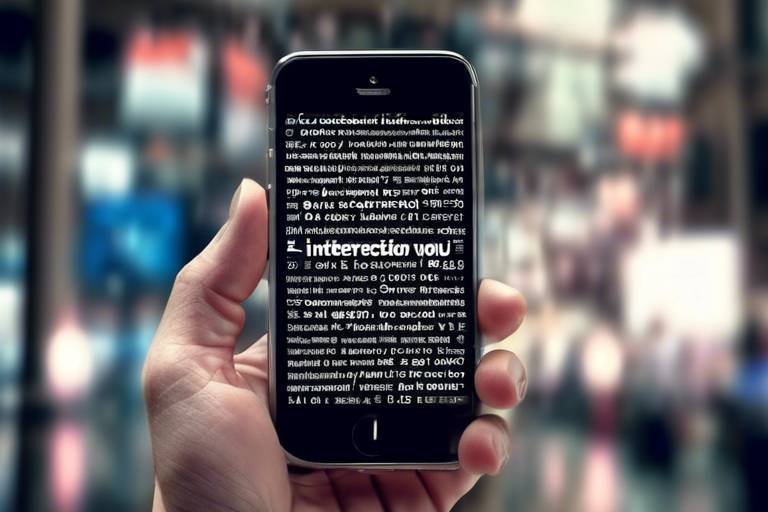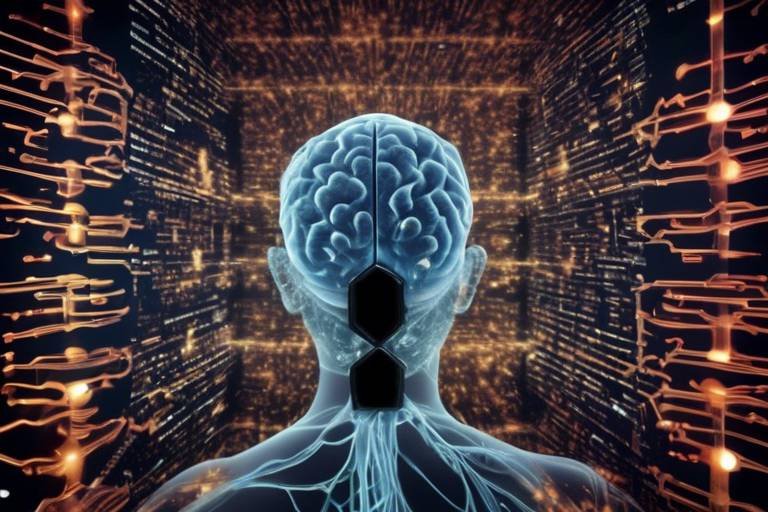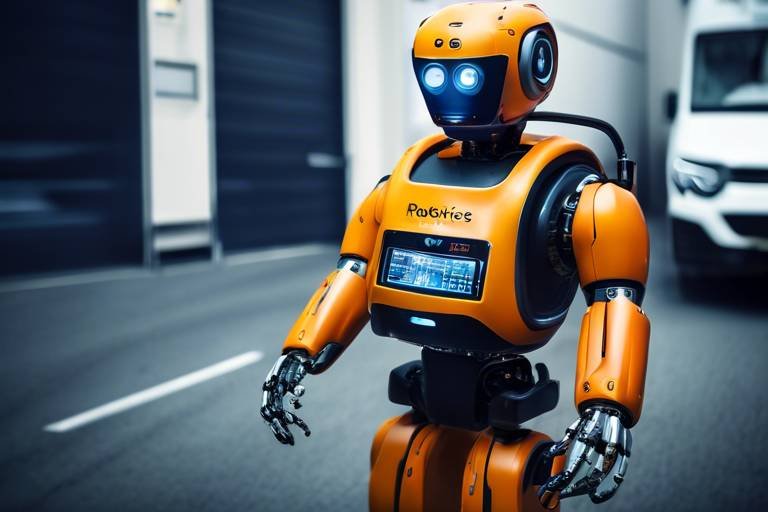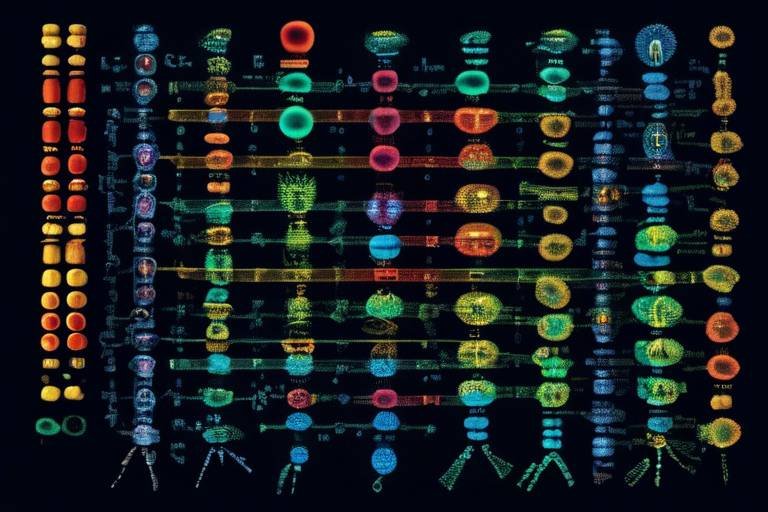How AI is Influencing the Future of Transportation
In today's fast-paced world, artificial intelligence (AI) is not just a buzzword; it is a transformative force reshaping various industries, and transportation is at the forefront of this revolution. Imagine a future where your morning commute is smooth, safe, and efficient, where vehicles communicate with each other and traffic signals adapt to real-time conditions. This isn't a scene from a sci-fi movie; it's the reality that AI is helping to create. From autonomous vehicles to smart traffic management systems, AI is paving the way for a new era of transportation that promises to enhance safety, reduce congestion, and promote sustainability.
The potential of AI in transportation is vast and multifaceted. With autonomous vehicles becoming more sophisticated, we are witnessing a shift in how we think about mobility. These self-driving cars are equipped with advanced sensors and machine learning algorithms that allow them to navigate roads, avoid obstacles, and even communicate with other vehicles. This technology isn't just about convenience; it's about reducing accidents and saving lives. According to recent studies, a significant percentage of traffic accidents are caused by human error, and by leveraging AI, we can drastically decrease these incidents. So, what does this mean for urban mobility? It opens up a world of possibilities where traffic flows more freely, and public spaces can be reimagined.
But the influence of AI doesn't stop at autonomous vehicles. It extends into the realm of traffic management, where AI technologies are optimizing traffic flow and reducing congestion. Imagine driving through a city where traffic signals are not just fixed timers but intelligent systems that adapt to real-time conditions. Smart traffic signals analyze traffic patterns and adjust their timings accordingly, leading to improved efficiency on the roads. This dynamic approach not only reduces wait times but also lowers emissions, contributing to a healthier planet.
However, the implementation of such technologies is not without its challenges. Cities face hurdles such as funding and the need for updated infrastructure. Despite these obstacles, the potential benefits—both environmental and economic—are too significant to ignore. By investing in smart traffic systems, cities can enhance the quality of life for their residents while also attracting businesses and tourism.
Moreover, AI is enhancing public transportation systems in unprecedented ways. With predictive analytics, transit authorities can forecast demand and adjust services accordingly. This means that buses and trains can be deployed where and when they are needed most, leading to increased efficiency and user satisfaction. Imagine being able to check your phone and see that the next bus is only two minutes away, or that a train is arriving just in time to connect with your schedule. AI is making these scenarios a reality.
Another exciting development is the use of AI-driven customer experience enhancements in public transport. From personalized services to intelligent chatbots that provide real-time information, AI is transforming the way passengers interact with transit systems. No longer do commuters have to rely on static schedules; they can receive updates tailored to their specific needs, making travel more convenient and enjoyable.
But what about sustainability? In an era where climate change is a pressing concern, AI is playing a crucial role in promoting sustainable transportation solutions. By optimizing logistics and developing eco-friendly vehicle technologies, AI can help reduce carbon footprints significantly. For instance, logistics companies are using AI to streamline their supply chains, minimizing unnecessary trips and fuel consumption. This not only saves money but also contributes to a cleaner environment.
As we look to the future, it’s clear that AI will continue to influence transportation in profound ways. The integration of these technologies promises a safer, more efficient, and sustainable transportation landscape. The journey is just beginning, and as we embrace these changes, we must also consider the ethical implications and ensure that technology serves all members of society equitably.
- What are autonomous vehicles? Autonomous vehicles are self-driving cars that use AI technology to navigate and operate without human intervention.
- How does AI improve traffic management? AI optimizes traffic flow by analyzing real-time data to adjust traffic signals and improve routing.
- What is predictive analytics in transportation? Predictive analytics uses historical data to forecast demand and optimize public transportation services.
- How can AI contribute to sustainability in transportation? AI can help reduce carbon footprints through smarter logistics and the development of eco-friendly vehicle technologies.

The Rise of Autonomous Vehicles
Autonomous vehicles are not just a futuristic dream; they are rapidly becoming a reality that is transforming the way we think about transportation. Imagine a world where your car drives you to work while you sip your morning coffee or catch up on your favorite podcast. Sounds appealing, right? With advancements in artificial intelligence (AI), this scenario is closer than ever. The technology behind self-driving cars leverages complex algorithms and machine learning to navigate roads, recognize obstacles, and make split-second decisions, all while ensuring passenger safety.
At the heart of autonomous vehicle technology is a combination of sensors, cameras, and AI systems that work in harmony to create a comprehensive understanding of the vehicle's surroundings. These vehicles are equipped with:
- LiDAR (Light Detection and Ranging): This technology uses laser light to measure distances and create a 3D map of the environment.
- Radar: Radar systems detect the speed and distance of objects, which is crucial for collision avoidance.
- Cameras: High-definition cameras provide visual information that helps the vehicle interpret traffic signals, lane markings, and pedestrians.
As these technologies improve, the potential impact on urban mobility is staggering. Picture cities with fewer cars on the road, reduced traffic congestion, and a significant drop in accidents caused by human error. Autonomous vehicles could lead to a paradigm shift in how we approach urban planning and public transport. For instance, with the integration of self-driving taxis and shuttles, the need for personal car ownership could diminish, paving the way for a more communal approach to transportation.
However, the rise of autonomous vehicles is not just about convenience; it also carries profound implications for safety and efficiency. Studies have shown that human error accounts for approximately 94% of traffic accidents. By removing the human element from the driving equation, we could potentially save countless lives and reduce the burden on emergency services. Moreover, autonomous vehicles can optimize driving patterns, leading to smoother traffic flow and lower fuel consumption.
That said, the transition to a future dominated by autonomous vehicles is not without its challenges. Regulatory frameworks must evolve to accommodate these new technologies, and public acceptance is crucial. Many people may feel uneasy about relinquishing control to a machine, raising questions about trust and reliability. As we navigate this exciting yet uncertain landscape, it's essential to engage in open dialogues about the benefits and risks associated with self-driving technology.
In conclusion, the rise of autonomous vehicles is set to revolutionize transportation as we know it. With safety, efficiency, and urban mobility at the forefront, we are on the brink of a new era in travel. As we embrace this technological advancement, it's vital to remain informed and proactive about the changes it will bring to our daily lives.

AI in Traffic Management
Imagine sitting in your car, stuck in traffic, feeling the frustration build as the minutes tick by. Now, picture a world where that frustration is significantly reduced, thanks to the incredible advancements in artificial intelligence. AI is not just a buzzword; it's a game-changer in the realm of traffic management. By leveraging powerful algorithms and real-time data, AI technologies are optimizing traffic flow like never before, transforming our daily commutes into smoother, more efficient journeys.
At the heart of AI in traffic management is the use of machine learning algorithms, which analyze vast amounts of data from various sources such as traffic cameras, sensors, and GPS devices. This data-driven approach enables cities to implement smarter traffic systems that can adapt to changing conditions. For instance, during rush hour, these systems can adjust traffic signals to accommodate heavier traffic flows, ensuring that vehicles move more efficiently through intersections.
One of the most exciting innovations in traffic management is the deployment of smart traffic signals. These signals are not your typical stoplights; they are equipped with advanced sensors and AI capabilities that allow them to monitor real-time traffic patterns. When traffic is heavy on one road, the smart signal can automatically extend the green light duration, reducing wait times and preventing bottlenecks. This dynamic adjustment is akin to having a personal traffic conductor, orchestrating the flow of vehicles to perfection.
The advantages of implementing smart traffic signals are manifold. Not only do they lead to reduced wait times, but they also contribute to lower emissions. By minimizing idle times at intersections, vehicles burn less fuel, which is a win-win for both commuters and the environment. A recent study highlighted that cities with smart traffic systems experienced a 20% reduction in travel time and a corresponding decrease in greenhouse gas emissions. This is a significant step towards creating greener urban spaces.
However, the road to integrating smart traffic signals isn't without its bumps. Cities face several challenges, including funding and the need for upgraded infrastructure. Many municipalities struggle to allocate budget for these advanced systems, often prioritizing immediate concerns over long-term benefits. Additionally, the existing infrastructure may not be compatible with new technologies, requiring extensive upgrades that can be both time-consuming and costly. But despite these hurdles, the potential benefits of smart traffic management systems are too significant to ignore.
AI-driven real-time traffic analysis is another crucial component of modern traffic management. By collecting and analyzing data from various sources, cities can gain valuable insights into traffic patterns, peak congestion times, and even accident hotspots. This information is vital for commuters, as it enhances navigation apps and public transport systems. For example, if an accident occurs on a major highway, traffic analysis can quickly reroute drivers, helping them avoid delays. It's like having a personal assistant that knows the best routes and keeps you informed about the quickest way to your destination.
In summary, the integration of is paving the way for smarter, more efficient urban transportation systems. From smart traffic signals to real-time analysis, AI is helping us navigate our cities with ease, reducing congestion, and enhancing the overall commuting experience. As cities continue to embrace these technologies, we can only imagine how much smoother our daily travels will become.
- How does AI improve traffic management? AI improves traffic management by analyzing real-time data to optimize traffic flow, adjust signal timings, and reduce congestion.
- What are smart traffic signals? Smart traffic signals are advanced traffic lights equipped with sensors and AI that adapt to real-time traffic conditions to improve efficiency.
- What are the environmental benefits of AI in traffic management? AI helps reduce emissions by minimizing idle times at traffic signals, leading to less fuel consumption and a smaller carbon footprint.
- What challenges do cities face in implementing AI traffic systems? Cities often face challenges such as funding limitations and the need for infrastructure upgrades when implementing AI traffic systems.

Smart Traffic Signals
Imagine driving through a city where traffic signals are not just mindlessly switching from red to green, but are instead intelligently adapting to the flow of vehicles and pedestrians. This is the promise of , a groundbreaking innovation made possible by artificial intelligence. These systems leverage real-time data to optimize signal timings, ensuring that traffic moves smoothly and efficiently. By utilizing advanced sensors and machine learning algorithms, smart traffic signals can analyze traffic patterns and adjust their operations dynamically, reducing congestion and enhancing safety.
So, how do these high-tech signals work? At their core, they collect data from various sources, including road sensors, cameras, and even connected vehicles. This data is then processed using AI to determine the best timing for each signal based on current traffic conditions. For example, during rush hour, a smart traffic signal might extend the green light for a busy street while shortening the wait time for side streets. This adaptability not only improves the flow of traffic but also minimizes the time drivers spend idling at red lights, which can lead to significant reductions in fuel consumption and emissions.
Moreover, the benefits of smart traffic signals extend beyond just traffic management. They can also enhance pedestrian safety by adjusting signals based on foot traffic. In busy urban areas, for instance, these systems can prioritize pedestrian crossings when large groups of people are waiting to cross the street. This feature is particularly important in enhancing the overall urban mobility experience, making cities more livable and reducing the likelihood of accidents.
However, implementing smart traffic signals is not without its challenges. Cities must invest in the necessary infrastructure, which can be costly and time-consuming. Additionally, ensuring that these systems are integrated with existing traffic management frameworks requires careful planning and coordination. Despite these hurdles, the potential rewards are substantial, with cities that adopt smart traffic signals seeing improvements in traffic flow and reductions in travel times.
As we look toward the future, the role of smart traffic signals in urban environments will only continue to grow. They represent a significant step forward in the quest for efficient and sustainable transportation, blending technology with urban planning to create safer, more efficient cities. The question remains: are we ready to embrace this technology and revolutionize the way we navigate our urban landscapes?
- What are smart traffic signals? Smart traffic signals are traffic lights that use artificial intelligence and real-time data to optimize traffic flow and improve safety.
- How do smart traffic signals work? They collect data from sensors and cameras, analyze traffic patterns, and adjust signal timings accordingly to enhance efficiency.
- What are the benefits of smart traffic signals? They reduce congestion, minimize wait times, improve pedestrian safety, and help decrease fuel consumption and emissions.
- What challenges do cities face in implementing smart traffic signals? Major challenges include funding, the need for new infrastructure, and integration with existing traffic management systems.

Benefits of Smart Signals
Implementing smart traffic signals brings a plethora of benefits that go beyond mere convenience. These advanced systems leverage the power of artificial intelligence to enhance urban mobility, making our roads safer and more efficient. Imagine a city where traffic flows smoothly, reducing the frustration of long waits at red lights. This is not just a dream; it's a reality made possible through smart signals.
One of the most significant advantages of smart signals is the reduction in wait times. Traditional traffic signals operate on fixed timers, often leading to unnecessary delays even when no vehicles are present. In contrast, smart signals adapt to real-time traffic conditions, adjusting their timings based on current flow. This adaptability not only minimizes idle time at intersections but also contributes to a smoother overall traffic experience.
Moreover, the environmental impact of smart signals cannot be overlooked. By optimizing traffic flow, these systems help to lower vehicle emissions. When cars spend less time idling, they consume less fuel, which directly correlates to a decrease in greenhouse gas emissions. According to studies, cities that have implemented smart traffic management systems have observed a significant drop in air pollution levels, contributing to a healthier urban environment.
From an economic perspective, the benefits are equally compelling. Cities can save money by reducing the need for extensive road infrastructure upgrades. With smart signals in place, the existing infrastructure can handle increased traffic loads more efficiently. Additionally, the reduction in congestion translates to less wear and tear on vehicles, leading to lower maintenance costs for drivers.
Furthermore, smart signals enhance safety on the roads. By utilizing data analytics, these systems can identify patterns that indicate potential hazards, such as frequent accidents at specific intersections. With this information, city planners can implement targeted interventions, such as adjusting signal timings or adding pedestrian crossings, to mitigate risks and enhance overall safety.
In conclusion, the benefits of smart signals extend far beyond just improving traffic flow. They play a vital role in reducing wait times, lowering emissions, saving money, and enhancing safety. As cities continue to embrace this technology, we can look forward to a future where our transportation systems are not only smarter but also more sustainable and user-friendly.

Challenges of Implementation
While the integration of smart traffic signals offers numerous advantages, cities face a myriad of challenges that can hinder their successful implementation. One of the primary hurdles is funding. Securing the necessary budget for such advanced technology can be daunting, especially for municipalities already grappling with tight financial constraints. Governments often need to prioritize between various infrastructure projects, and smart traffic signals might not always make the cut.
Additionally, infrastructure plays a critical role in the implementation process. Many cities have aging traffic systems that require significant upgrades to accommodate new technologies. This includes not just the signals themselves but also the underlying networks that support data collection and analysis. Upgrading these systems can be both time-consuming and expensive, leading to delays in deployment.
Moreover, there is often a lack of technical expertise within local governments. Implementing AI-driven solutions requires specialized knowledge in both technology and data analytics. Many cities may not have the personnel trained to manage these systems effectively, which can lead to inefficiencies and underutilization of the technology. As a result, cities might find themselves needing to invest in training or hiring new staff, further straining their budgets.
Another significant challenge is the public perception of smart traffic signals. Many residents may be skeptical about the effectiveness of AI in managing traffic and could be resistant to changes in their daily commutes. This skepticism can lead to pushback against new installations, making it crucial for city planners to engage with the community and educate them about the benefits of these systems. Transparent communication can help alleviate fears and foster a sense of ownership among residents.
Finally, there are also regulatory hurdles that need to be navigated. Different regions may have varying laws and regulations regarding technology deployment in public spaces. This can complicate the process of rolling out smart traffic signals, as cities must ensure compliance with all relevant guidelines and standards. The need for collaboration between various governmental agencies can slow down the implementation process, creating further delays.
In summary, while the promise of smart traffic signals is enticing, cities must address these challenges head-on. By securing funding, upgrading infrastructure, investing in training, engaging the public, and navigating regulatory landscapes, municipalities can pave the way for a smoother transition into a more efficient and sustainable transportation future.
- What are smart traffic signals? Smart traffic signals use AI and real-time data to optimize traffic flow and reduce congestion.
- How do smart traffic signals improve safety? By analyzing traffic patterns, they can adjust signal timings to minimize accidents and improve pedestrian safety.
- What are the costs associated with implementing smart traffic signals? Costs can vary widely based on the existing infrastructure, technology chosen, and the scale of the deployment.
- How can cities overcome funding challenges? Cities can explore public-private partnerships, grants, and state or federal funding initiatives to secure necessary resources.

Real-Time Traffic Analysis
Imagine you're stuck in traffic, your patience wearing thin, and you're late for an important meeting. Now, picture a world where your navigation app not only tells you the fastest route but also predicts traffic jams before they happen. This isn't just wishful thinking; it's the magic of real-time traffic analysis powered by artificial intelligence. AI leverages vast amounts of data collected from various sources, including traffic cameras, sensors, and even social media, to provide insights that can revolutionize your daily commute.
Real-time traffic analysis uses advanced algorithms to interpret data in the blink of an eye. These algorithms can identify patterns and trends, allowing them to forecast traffic conditions with remarkable accuracy. For instance, if a major event is happening downtown, AI can analyze historical data and current traffic flows to predict how this will affect congestion levels. This means that commuters can receive timely alerts about potential delays and alternative routes, making their journeys smoother and less stressful.
Furthermore, cities equipped with AI-driven traffic management systems can optimize the flow of vehicles on the road. By analyzing real-time data, these systems can adjust traffic signals dynamically, ensuring that the green light is on for the most congested routes. This not only reduces wait times but also minimizes fuel consumption and emissions. A recent study showed that cities implementing AI traffic management saw a 20% reduction in congestion within the first year.
To illustrate the impact of real-time traffic analysis, consider the following table that highlights the key benefits:
| Benefit | Description |
|---|---|
| Improved Navigation | AI provides real-time updates, helping drivers avoid congested routes. |
| Reduced Emissions | Optimized traffic flow leads to lower fuel consumption and emissions. |
| Enhanced Safety | Fewer traffic jams result in reduced accident rates. |
Moreover, this technology isn't just beneficial for individual drivers. Public transportation systems also gain a significant advantage from real-time traffic analysis. By understanding traffic patterns, transit authorities can adjust bus and train schedules to meet demand, ensuring that services are reliable and efficient. Passengers enjoy shorter wait times and a more predictable travel experience, which encourages greater use of public transport.
In summary, the integration of AI in real-time traffic analysis is not just a technological advancement; it's a game-changer for urban mobility. As cities continue to grow and traffic congestion becomes an even more pressing issue, the ability to analyze and respond to real-time conditions will be essential. With AI at the helm, we can look forward to a future where commuting is not a chore but a seamless part of our daily lives.
- What is real-time traffic analysis? Real-time traffic analysis refers to the use of AI and data to monitor and predict traffic conditions, allowing for better navigation and traffic management.
- How does AI improve traffic flow? AI analyzes data from various sources to adjust traffic signals and provide real-time updates to drivers, helping to alleviate congestion.
- Can real-time traffic analysis benefit public transportation? Yes, it helps optimize routes and schedules, leading to improved reliability and user satisfaction.
- What are the environmental benefits of AI in traffic management? By reducing congestion and optimizing traffic flow, AI can lower fuel consumption and emissions, contributing to a cleaner environment.

Enhancing Public Transportation
In today's fast-paced world, public transportation plays a pivotal role in ensuring that cities remain connected and accessible. However, with the increasing population and urbanization, traditional public transport systems often struggle to meet the demands of commuters. This is where artificial intelligence (AI) steps in, revolutionizing the way we think about and utilize public transportation. By harnessing the power of data and predictive analytics, AI is not just improving the efficiency of transit systems; it's also enhancing the overall experience for passengers.
One of the most significant advancements in this realm is the application of predictive analytics. This technology allows transit authorities to forecast demand based on various factors such as time of day, weather conditions, and historical data. Imagine a bus service that knows how many people are likely to need a ride at a specific time and adjusts its schedules accordingly. This means fewer overcrowded buses and less waiting time for commuters. With AI, we can say goodbye to the days of guessing how many buses are needed on a particular route.
Furthermore, AI is enhancing the customer experience in public transport. Think about the last time you were waiting at a bus stop, unsure of when your bus would arrive. With AI-driven systems, passengers can receive real-time updates through mobile apps or digital displays at stations. These systems can provide information on delays, alternative routes, and even suggest the best times to travel. Chatbots powered by AI are also becoming commonplace, offering assistance and answering questions for passengers on the go. This means that whether you’re a daily commuter or a tourist, you can navigate public transportation with ease and confidence.
Moreover, AI is facilitating the integration of various modes of transport. For instance, imagine a scenario where you can seamlessly transition from a train to a bus, or even to a bike-sharing service, all coordinated through a single application. This holistic approach not only improves efficiency but also encourages more people to opt for public transport over personal vehicles, ultimately leading to a reduction in traffic congestion and emissions.
However, while the benefits of AI in public transportation are clear, there are challenges that need to be addressed. Implementing these advanced systems requires significant investment in technology and infrastructure. Cities must not only invest in the latest AI technologies but also ensure that their existing systems can integrate with new solutions. This can be a daunting task, especially for smaller municipalities with limited budgets.
In conclusion, as we continue to explore the potential of AI in enhancing public transportation, it’s essential to recognize its transformative power. By improving efficiency, customer experience, and integration, AI is paving the way for a more sustainable and user-friendly transit system. The future of public transportation looks promising, and with AI at the helm, we can expect a revolution that not only meets the needs of today’s commuters but also anticipates the demands of tomorrow.
- How does AI improve public transportation?
AI enhances public transportation by using predictive analytics to optimize routes and schedules, improving efficiency and reducing wait times for passengers. - What are the benefits of using AI in public transport?
The benefits include better customer experience through real-time updates, reduced overcrowding, and seamless integration of different transport modes. - Are there challenges to implementing AI in public transportation?
Yes, challenges include the need for significant investment in technology and infrastructure, especially for smaller cities.

Predictive Analytics in Transportation
Predictive analytics is rapidly becoming a game-changer in the world of transportation. By harnessing the power of big data and advanced algorithms, transportation authorities can forecast demand and optimize services like never before. Imagine being able to predict how many passengers will board a bus at a specific stop at a certain time of day. This is not just a dream; it’s a reality made possible through predictive analytics. With this technology, cities can adjust routes and schedules in real-time, ensuring that public transport is not only efficient but also user-friendly.
The core of predictive analytics lies in its ability to analyze historical data and identify patterns. For instance, if data shows that a particular bus route experiences higher traffic during rush hours, transit authorities can deploy additional buses during those times. This not only improves service reliability but also enhances the overall experience for commuters. By reducing wait times and overcrowding, public transportation becomes a more attractive option for daily travel, ultimately encouraging more people to leave their cars at home.
Moreover, predictive analytics can play a significant role in safety management. By analyzing data from previous incidents, authorities can identify high-risk areas and take preventive measures. This could involve adjusting routes, increasing surveillance, or even enhancing lighting in poorly lit areas. The goal is to create a safer environment for all commuters, whether they are on a bus, train, or simply walking to their destination.
In addition to improving public transport, predictive analytics also aids in traffic management. By understanding traffic patterns and predicting congestion, cities can implement strategies that enhance traffic flow. For instance, if a major event is scheduled in a particular area, predictive analytics can help in planning detours and adjusting traffic signals accordingly. This proactive approach can significantly reduce frustration for drivers and improve overall mobility in urban areas.
To illustrate the impact of predictive analytics, consider the following table that highlights its benefits in transportation systems:
| Benefit | Description |
|---|---|
| Improved Efficiency | Optimizes routes and schedules based on real-time data. |
| Increased Reliability | Reduces wait times and overcrowding by adjusting services to match demand. |
| Enhanced Safety | Identifies high-risk areas to implement preventive measures. |
| Better Traffic Flow | Helps manage congestion through real-time traffic analysis. |
In conclusion, predictive analytics is revolutionizing transportation by making it smarter and more responsive to the needs of commuters. As cities continue to evolve and grow, the integration of predictive analytics will be crucial in shaping a transportation system that is not only efficient but also sustainable and safe for everyone.
- What is predictive analytics in transportation?
Predictive analytics in transportation refers to the use of data analysis techniques to forecast future trends and behaviors, enabling more efficient management of transport services. - How does predictive analytics improve public transportation?
It allows transit authorities to adjust routes and schedules based on anticipated demand, leading to reduced wait times and increased passenger satisfaction. - Can predictive analytics enhance safety in transportation?
Yes, by analyzing historical incident data, predictive analytics can identify high-risk areas and help implement safety measures. - What role does big data play in predictive analytics?
Big data provides the vast amounts of information necessary for accurate analysis and forecasting, making predictive analytics effective.

AI-Driven Customer Experience
In today's fast-paced world, where time is of the essence, the customer experience in public transportation is more critical than ever. With the integration of artificial intelligence, transit authorities are not just keeping up; they are leaping ahead to provide services that are more personalized, efficient, and user-friendly. Imagine walking into a transit station and instantly receiving tailored information about your journey. Sounds futuristic, right? But this is the reality that AI is crafting for us!
One of the most exciting advancements is the use of chatbots and virtual assistants. These AI-powered tools can interact with passengers in real-time, answering questions, providing updates, and assisting with trip planning. For instance, if a commuter is unsure about the best route to take during peak hours, a chatbot can analyze current traffic conditions and suggest the fastest option. This not only enhances the user experience but also reduces stress for commuters who often feel overwhelmed by travel logistics.
Furthermore, AI can analyze vast amounts of data to understand passenger behavior better. By identifying trends and patterns, public transport systems can offer personalized services that cater to individual needs. For example, if a significant number of commuters frequently travel from one neighborhood to another during specific hours, transit authorities can adjust schedules or add more vehicles to accommodate this demand. This proactive approach not only improves service reliability but also builds trust and satisfaction among users.
Additionally, AI can power mobile applications that provide real-time updates on schedules and delays. Imagine having an app that not only tells you when the next bus is arriving but also alerts you if there’s a delay, allowing you to make informed decisions about your travel plans. Such features make public transportation a more attractive option for many, especially in urban areas where congestion is a common challenge.
To illustrate the impact of AI on customer experience, consider the following table that compares traditional public transport services with AI-enhanced services:
| Feature | Traditional Services | AI-Enhanced Services |
|---|---|---|
| Real-Time Updates | Limited information | Instant notifications on delays and arrivals |
| Customer Support | In-person assistance only | 24/7 chatbot support |
| Route Optimization | Fixed schedules | Dynamic routing based on demand |
| Personalization | Generic services | Tailored recommendations and alerts |
As we embrace these AI-driven enhancements, it's essential to acknowledge the potential challenges. While the technology offers immense benefits, there is a need for continuous improvement and adaptation. Public transport authorities must invest in the necessary infrastructure and training to ensure that AI systems are effectively integrated into existing frameworks. However, the rewards of doing so—greater efficiency, improved customer satisfaction, and a more accessible transit system—are undoubtedly worth the effort.
- How does AI improve the customer experience in public transportation?
AI enhances customer experience by providing real-time updates, personalized services, and efficient route optimization. - Are chatbots effective in assisting commuters?
Yes, chatbots can provide instant support and information, making travel planning easier for commuters. - What challenges do transit authorities face when implementing AI?
Challenges include funding, infrastructure upgrades, and the need for staff training. - How can AI help in reducing wait times?
AI can analyze traffic patterns and adjust schedules dynamically, leading to reduced wait times for passengers.

Sustainability and AI
In today's world, where climate change and environmental degradation are pressing concerns, the intersection of artificial intelligence (AI) and sustainability is more crucial than ever. AI is not just a buzzword; it's a powerful tool that can significantly reduce our carbon footprint and promote eco-friendly practices across various sectors, particularly in transportation. Imagine a world where logistics are optimized to minimize waste, or where electric vehicles (EVs) are powered by smart grid technology that maximizes renewable energy usage. This is the future that AI is helping us to create.
One of the most exciting aspects of AI in sustainability is its ability to revolutionize logistics and supply chain management. Traditional logistics often involves a lot of guesswork, leading to inefficiencies and increased emissions. However, with AI algorithms that analyze vast amounts of data, companies can optimize routes, reduce delivery times, and cut down on fuel consumption. For instance, AI can predict traffic patterns and weather conditions, allowing delivery trucks to take the most efficient paths. This not only saves money but also significantly lowers greenhouse gas emissions.
Moreover, AI is making strides in the development of eco-friendly vehicle technologies. For example, AI systems are now being used to enhance the performance of electric vehicles. These systems can monitor battery health, optimize charging schedules, and even suggest routes that conserve energy. The integration of AI with electric vehicles means that we can expect longer ranges, faster charging times, and a more enjoyable driving experience. In fact, a recent study showed that AI-enhanced EVs can reduce energy consumption by up to 30% compared to traditional models.
Another area where AI is making an impact is in the realm of smart cities. Urban areas are often plagued by traffic congestion and pollution, but AI can help alleviate these issues through intelligent transportation systems. By analyzing real-time data from various sensors and cameras, AI can optimize traffic flow, reduce idle times, and minimize emissions. Take a look at the following table that summarizes some key benefits of AI in smart city initiatives:
| Benefit | Description |
|---|---|
| Reduced Emissions | AI optimizes traffic flow, leading to fewer stops and less idling. |
| Improved Efficiency | Real-time data helps in making quick adjustments to traffic signals and routes. |
| Enhanced Public Safety | AI can predict and manage potential traffic accidents, improving overall safety. |
However, while the potential of AI to promote sustainability is immense, it’s essential to address the challenges that come with its implementation. For instance, the initial investment in AI technologies can be substantial. Many cities and organizations may struggle to find the necessary funding to integrate these advanced systems. Additionally, there are concerns about data privacy and security, as AI relies heavily on data collection. Balancing these challenges with the benefits is crucial for a successful transition towards a sustainable future.
To sum it up, AI is not just a technological advancement; it’s a pathway to a more sustainable world. By optimizing transportation systems, enhancing vehicle technologies, and facilitating smart city initiatives, AI is paving the way for a greener future. As we continue to innovate and embrace these technologies, we must remain committed to leveraging AI to combat climate change and promote sustainability in every facet of our lives.
- How does AI help reduce carbon emissions in transportation?
AI optimizes routes and traffic flow, which reduces idle times and fuel consumption, leading to lower emissions. - What are smart cities?
Smart cities use technology, including AI, to improve urban infrastructure, reduce traffic congestion, and enhance the quality of life for residents. - Are there any downsides to implementing AI in sustainability efforts?
Yes, challenges include high initial costs, data privacy concerns, and the need for robust infrastructure.
Frequently Asked Questions
- What are autonomous vehicles and how do they work?
Autonomous vehicles, commonly known as self-driving cars, use a combination of sensors, cameras, and artificial intelligence to navigate without human intervention. They analyze their surroundings in real-time, making decisions based on the data collected to safely transport passengers and goods.
- How is AI improving traffic management?
AI enhances traffic management by utilizing machine learning algorithms to optimize traffic signals and improve routing. This technology analyzes traffic patterns and adjusts signal timings dynamically, leading to smoother traffic flow and reduced congestion.
- What are smart traffic signals?
Smart traffic signals are advanced systems that adapt to real-time traffic conditions. They use AI to analyze the volume and speed of vehicles, adjusting their timings to minimize wait times and improve overall traffic efficiency.
- What benefits do smart traffic signals offer?
Implementing smart traffic signals can significantly reduce wait times at intersections, lower emissions from idling vehicles, and enhance the overall efficiency of the transportation network. This results in a better experience for drivers and pedestrians alike.
- What challenges do cities face when implementing AI in traffic management?
Cities encounter several hurdles, including funding limitations, outdated infrastructure, and the need for comprehensive data collection systems. Overcoming these challenges is crucial for successfully integrating AI technologies into existing traffic management frameworks.
- How does AI enhance public transportation?
AI improves public transportation by utilizing predictive analytics to optimize routes and schedules based on demand forecasts. This ensures that services are more reliable and tailored to the needs of passengers, ultimately enhancing user satisfaction.
- What is predictive analytics in transportation?
Predictive analytics involves analyzing historical and real-time data to forecast future demand for public transportation services. Transit authorities can use this information to adjust schedules and routes, ensuring better service for commuters.
- How does AI improve the customer experience in public transport?
AI enhances the customer experience by providing personalized services, such as tailored travel recommendations and real-time updates via chatbots. This helps passengers stay informed and make better travel decisions.
- In what ways is AI contributing to sustainability in transportation?
AI promotes sustainability by optimizing logistics, reducing fuel consumption, and facilitating the development of eco-friendly vehicle technologies. By making transportation systems more efficient, AI helps lower carbon footprints and supports cleaner urban environments.

